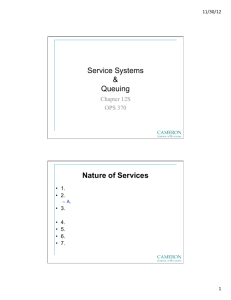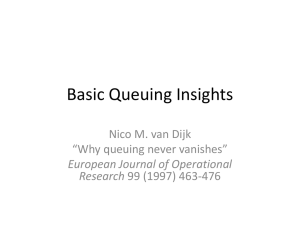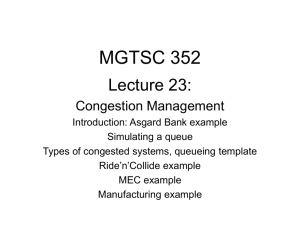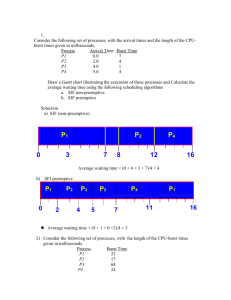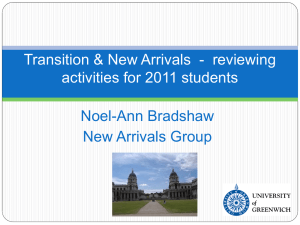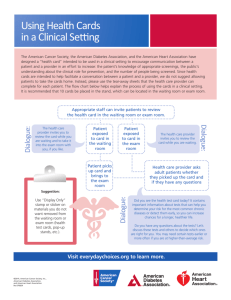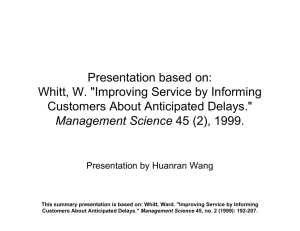PPT
advertisement
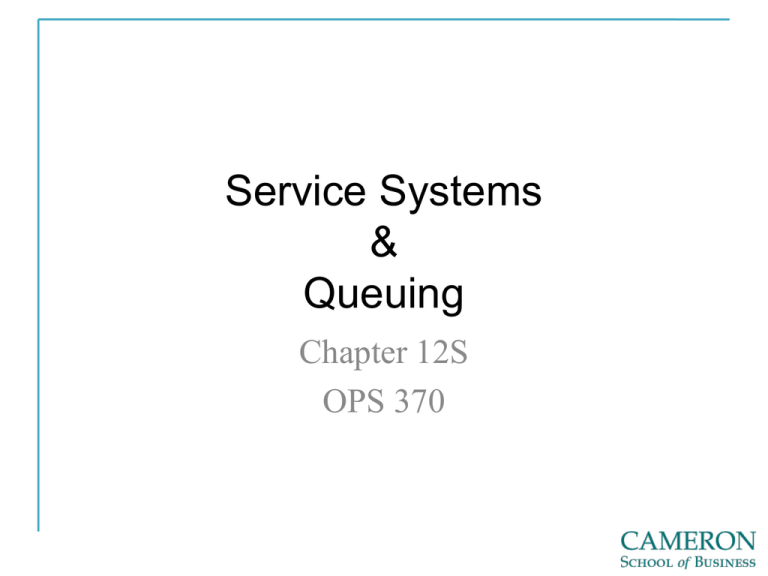
Service Systems & Queuing Chapter 12S OPS 370 Nature of Services • 1. • 2. – A. • 3. • • • • 4. 5. 6. 7. Service System Design Matrix Degree of customer/server contact High (low) None Some (Buffered System) (Permeable System) Face -to-face total customization Face -to-face loose specs Sales Opportunity? (Production Efficiency?) Low (high) Extensive (Reactive System) Face -to-face tight specs Mail contact Internet & on-site technology Phone Contact Designs for On-Site Service • 1. – Ex: • 2. – Ex. • 3. – Ex. Disney World • 1. • 2. • 3. Implications of Waiting Lines • • • • 1. 2. 3. 4. Elements of Waiting Lines • 1. • 2. – A. – B. • 3. • 4. Customer Population Characteristics • 1. – A. • 2. – A. • 3. – A. • 4. Jockeying – A. Service System • 1. The service system is defined by: – A. – B. – C. – D. – E. Number of Lines • 1. Waiting lines systems can have single or multiple queues. – A. – B. Servers • 1. • 2. – A. – B. Example of a multi-phase, multi-server system: 1 Arrivals C C C 2 4 C C 5 3 6 Phase 1 Phase 2 Depart Example Queuing Systems Arrival & Service Patterns • Arrival rate: – 1. The average number of customers arriving per time period – 2. Modeled using the Poisson distribution – 3. Arrival rate usually denoted by lambda () – 4. Example: =50 customers/hour; 1/=0.02 hours between customer arrivals (1.2 minutes between customers) Arrival & Service Patterns (Continued) • Service rate: – 1. The average number of customers that can be served during the period of time – 2. Service times are usually modeled using the exponential distribution – 3. Service rate usually denoted by mu (µ) – 4. Example: µ=70 customers/hour; 1/µ=0.014 hours per customer (0.857 minutes per customer). • Even if the service rate is larger than the arrival rate, waiting lines form! – 1. Reason is the variation in specific customer arrival and service times. Waiting Line Priority Rules • • • • • • • 1. First come, first served 2. Best customers first (reward loyalty) 3. Highest profit customers first 4. Quickest service requirements first 5. Largest service requirements first 6. Earliest reservation first 7. Emergencies first Waiting Line Performance Measures • Lq = The average number of customers waiting in queue • L = The average number of customers in the system • Wq = The average waiting time in queue • W = The average time in the system • r = The system utilization rate (% of time servers are busy) Single-Server Waiting Line • Assumptions – 1. Customers are patient (no balking, reneging, or jockeying) – 2. Arrivals follow a Poisson distribution with a mean arrival rate of . This means that the time between successive customer arrivals follows an exponential distribution with an average of 1/ – 3. The service rate is described by a Poisson distribution with a mean service rate of µ. This means that the service time for one customer follows an exponential distribution with an average of 1/µ – 4. The waiting line priority rule is first-come, first-served – 5. Infinite population Formulas: Single-Server Case lambda mean arrival rate mu mean service rate r average system utilization Note: for system stability. If this is not the case, an infinitly long line will eventually form. Formulas: Single-Server Case con’t L average number of customers in system Lq r L average number of customers in line 1 W average time in system including service Wq rW average time spent waiting Pn 1 r r n probability of n customers in the system at a given point in time State Univ Computer Lab • A help desk in the computer lab serves students on a first-come, first served basis. On average, 15 students need help every hour. The help desk can serve an average of 20 students per hour. • Based on this description, we know: – 1. µ = 20 students/hour (average service time is 3 minutes) – 2. = 15 students/hour (average time between student arrivals is 4 minutes) Average Utilization 15 r 0.75 or 75% 20 Average Number of Students in the System, and in Line 15 L 3 students 20 15 Lq r L 0.75 3 2.25 students Average Time in the System & in Line 1 1 W 0.2 hours 20 15 or 12 minutes Wq rW 0.75 0.2 0.15 hours or 9 minutes Probability of n Students in the Line P0 1 r r 1 0.75 1 0.25 0 P1 1 r r 1 0.75 0.75 0.188 1 P2 1 r r 1 0.75 0.75 0.141 2 2 P3 1 r r 3 1 0.75 0.753 0.105 P4 1 r r 1 0.75 0.75 0.079 4 4 Single Server: Probability of n Students in the System Probability of Number in System 0.3000 0.2000 0.1500 0.1000 0.0500 Number in System 30 28 26 24 22 20 18 16 14 12 10 8 6 4 2 0.0000 0 Probability 0.2500 Multiple Server Case • Assumptions – 1. Same as SingleServer, except here we have multiple, parallel servers – 2. Single Line – 3. When server finishes with customer, first person in line goes to the idle server – 4. All servers are identical Multiple Server Formulas lambda mean arrival rate mu mean service rate for one server s number of parallel, identical servers r average system utilization s Note: s for system stability. If this is not the case, an infinitly long line will eventually form. Multiple Server Formulas con’t 1 / / 1 P0 probability of zero s ! 1 r n 0 n ! customers in the system at a given point in time s 1 n s / n P0 for n s n! Pn probability of n customers n / s ! s n s P0 for n s in the system at a given point in time Multiple Server Formulas (Continued) P0 / r s Lq s !1 r 2 average number of customers in line Wq Lq average time spent waiting in line W Wq 1 average time in system including service L W average number of customers in system Find Value for P0 from Chart Handout Example: Multiple Server • Computer Lab Help Desk • Now 45 students/hour need help. • 3 servers, each with service rate of 18 students/hour • Based on this, we know: – µ = 18 students/hour – s = 3 servers – = 45 students/hour Finding P0 r = 45/(3*18) = 0.83 P0 ≈ 0.04 Probability of n Students in the System Probability of Number in System 0.1600 0.1400 0.1000 0.0800 0.0600 0.0400 0.0200 Number in System 30 28 26 24 22 20 18 16 14 12 10 8 6 4 2 0.0000 0 Probability 0.1200 Changing System Performance • 1. Customer Arrival Rates – Ex: • 2. Number and type of service facilities – Ex. • 3. Change Number of Phases – Ex. Changing System Performance • 4. Server efficiency – Ex: – Ex: • 5. Change priority rules – Ex: • 6. Change the number of lines – Ex: – Ex:
